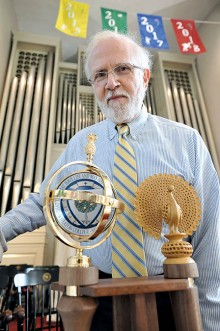A work of heart
Professor emeritus, brother create ceremonial pieces
 For the past two years, Professor of Psychology Emeritus David Wulff has been engaged in a project of the heart. With the help of his brother, Bernard—an architect, artist and woodworker—Wulff designed and created two ceremonial maces, symbols of authority used worldwide in formal processions at colleges and universities and on parliamentary occasions.
For the past two years, Professor of Psychology Emeritus David Wulff has been engaged in a project of the heart. With the help of his brother, Bernard—an architect, artist and woodworker—Wulff designed and created two ceremonial maces, symbols of authority used worldwide in formal processions at colleges and universities and on parliamentary occasions.
“They are my parting gift to Wheaton,” says Wulff, who retired in 2012 after 43 years at the college. The maces were used for the first time at the inauguration.
It was at his last Convocation that Wulff had an epiphany. Filling in as marshal for the ceremony, he carried a small, unassuming white baton. “I started thinking that Wheaton really needed a proper ceremonial mace, the ornamental descendant of the armor-piercing weapons once used to protect reigning monarchs,” he says.
Wulff wanted something worthy of the college he holds so dear. “Too many maces look like bedposts,” he says. After researching maces at other institutions, the brothers came up with the idea of a gyroscope to hold the college seal atop the mace. Guided by a picture of an antique gyroscope, Wulff created a prototype “constructed of embroidery hoops, gold paint, and a paper seal” that he presented to head administrators at Wheaton.
After receiving an enthusiastic thumbs-up, Wulff gathered materials and engaged the services of a dozen local craftsmen—including a machinist, a polisher, an engraver and a gold-plating specialist—to make his conception a reality.
The finished product is stunning. The gyroscope, which contains the college seal at its center, is designed so the seal remains upright no matter the mace’s positioning. The staff bears five gold rings engraved with significant dates in Wheaton’s history and a line from the college anthem, “Risking the storm while charting anew.”
Not wanting to leave the second marshal empty-handed, Wulff designed a secondary mace featuring a peacock he found, of all places, on eBay just weeks before the inauguration. Hand carved from kadam wood in the jali style of northern India, the peacock echoes the weathervane on Cole Memorial Chapel’s spire. Both maces are mounted on black walnut staffs, turned on a lathe by Wulff’s brother.
The maces are imbued with symbolic meaning. “The peacock signifies rebirth, immortality and auspicious events yet to unfold,” says Wulff. “The gyroscope is intended to suggest the steady life orientation that a liberal arts education provides.” And the rotating gimbals refer to Wheaton’s emphasis on global engagement. Depending on the occasion, one of three finials tops the primary mace—a pineapple (a sign of welcome), a laurel wreath (attainment) and a tree (growth, endurance and fruitfulness). An acorn on the foot of the mace signifies potential, strength and renewal.
Wulff is “extraordinarily pleased with how well all the elements turned out,” and he found the process—especially collaborating with his brother—to be a lot of fun.
“I feel very good about leaving [the maces] as a tangible legacy to Wheaton,” he says.